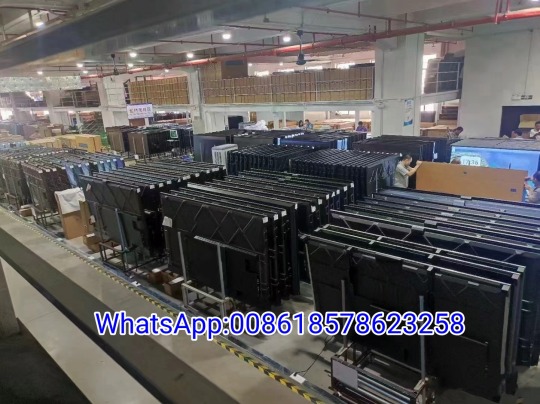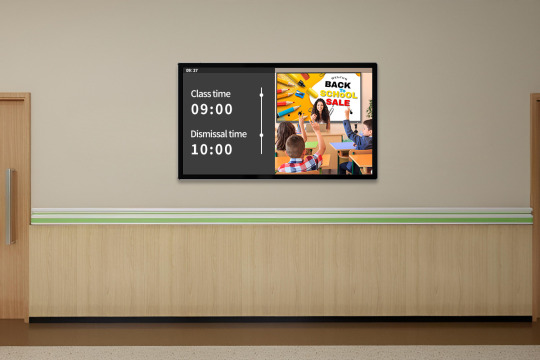#touch screen kiosks
Explore tagged Tumblr posts
Text
Cutting-edge LED digital screen suppliers in Dubai & Abu Dhabi. Leading supplier in UAE & Egypt.
#digital screen suppliers in dubai#kiosk manufacturers in dubai#led signage dubai#outdoor signage displays#digital advertising signs#digital signage kiosk solutions#touch screen kiosks
2 notes
·
View notes
Text
Replacing physical buttons and controls with touchscreens also means removing accessibility features. Physical buttons can be textured or have Braille and can be located by touch and don't need to be pressed with a bare finger. Touchscreens usually require precise taps and hand-eye coordination for the same task.
Many point-of-sale machines now are essentially just a smartphone with a card reader attached and the interface. The control layout can change at a moment's notice and there are no physical boundaries between buttons. With a keypad-style machine, the buttons are always in the same place and can be located by touch, especially since the middle button has a raised ridge on it.
Buttons can also be located by touch without activating them, which enables a "locate then press" style of interaction which is not possible on touchscreens, where even light touches will register as presses and the buttons must be located visually rather than by touch.
When elevator or door controls are replaced by touch screens, will existing accessibility features be preserved, or will some people no longer be able to use those controls?
Who is allowed to control the physical world, and who is making that decision?
#i get why this is happening; it's way cheaper to buy an off-the-shelf touch kiosk or tablet and run your ui on a web server#rather than integrating with custom hardware and physical inputs#but that should not just removing accessibility features#and I know that digital devices can help a lot with accessibility: e.g. screen readers#but I wouldn't rely on any of those being installed on someone else's device
49K notes
·
View notes
Text
Unlock a world of possibilities with Interactive LED Walls! Imagine the creativity and energy you can bring to any space – from office lobbies and conference rooms to sensory rooms, retail spaces and beyond. With their unlimited potential for dynamic visuals, interactive LED walls engage users in vibrant displays of color, message, or video and stellar sound quality, that captivate even the most tech-savvy audiences.
#interactive walls#interactive led wall technology#interactive touch wall#digital display screen#touch screen kiosks#LED video walls market#LED video walls#LED walls#LED video wall#LED video wall display
0 notes
Text
youtube
Smart Board Supplier | Cheap Interactive Flat Panel | Low Budget Interactive Whiteboard. WhatsApp:https://wa.me/008618578623258.
Interactive flat panels are revolutionizing the way we collaborate and communicate in various settings, from classrooms to corporate environments. As a leading supplier, we offer a range of high-quality interactive flat panel displays designed to enhance engagement and interactivity. Our products feature advanced touch technology, vibrant displays, and seamless connectivity options, making them ideal for presentations, teaching, and brainstorming sessions. With user-friendly interfaces and robust software compatibility, our interactive panels cater to diverse needs, ensuring an immersive experience. Partner with us to elevate your visual communication and transform your collaborative efforts with cutting-edge interactive solutions.


#Digital Signage#digital signage software#digital signage displays#digital board for teaching#digital signage and displays#totem touch screen#Digital Signage and Kiosk#Visual Solutions#commercial display#Education Digital Signage#Digital Signage Display System#Digital Signage Products and Solutions#Digital Signage Customized#Intelligent Digital Signage Solutions#Innovative Digital Signage System#digital signage solutions#digital signage companies#smart baord for teaching#inertactive flat panel for meeting#Touch sreen for Classroom
2 notes
·
View notes
Text
The Digital Standee Revolution in Hyderabad’s Retail Scene

Hyderabad’s retail industry is going hi-tech — and Maxx Electronic is leading the charge with our cutting-edge Digital Standees! 💡
From local boutiques to bustling malls, more and more businesses are turning to Digital Standee displays to grab attention, boost engagement, and showcase promotions like never before. Whether it’s a 32-inch wall-mounted display or a 65-inch freestanding marvel, our range is designed to elevate customer experience and drive sales.
Why are retailers loving them? ✅ Eye-catching visuals ✅ Easy content updates ✅ Space-saving designs ✅ Affordable pricing direct from the manufacturer
🎯 Based in Hyderabad, Maxx Electronic delivers reliable and sleek Digital Standees across Telangana & Andhra Pradesh.
Join the retail revolution today! 📲 DM us for quotes or visit: https://maxxelectronic.com
1 note
·
View note
Text
#Ipad rental Dubai#Ipad rental abudhabi#Ipad rental near me#Laptop Rental Dubai#Laptop rental near me#Laptop rental uae#Rent a laptop#Led TV rental Dubai#Led TV for rent near me#Touch screen rental Dubai#Touch display monitor#kiosk touch screen#Digital kiosk touch screen#Led video wall rental#Video wall rental
0 notes
Text
As businesses continue to adapt to the digital age, the adoption of interactive touch screen kiosks has become a game-changer in improving customer experience, streamlining operations, and enhancing business efficiency. These self-service kiosks, equipped with intuitive touch interfaces, have proven to be valuable assets for businesses across various sectors, from retail and hospitality to healthcare and transportation. Let’s explore the key benefits these interactive kiosks offer to modern businesses.
1 note
·
View note
Text
https://justpaste.it/1kjal
0 notes
Text
0 notes
Text
#Floor Standing Touch Screen Kiosk#Digital Signage Solutions#Digital Display Standee#Aluminum#Floor Standing Digital Signage#Digital Advertising Standee#OLED Led Display Standee#Double side#digital standee#Digital Signage Display#Digital Standee For Retail Stores android led standee#Interactive White Digital Board#Interactive Classroom Boards#PenTouch Interactive Flat Panel#Smart Board Interactive Flat Panel#Interactive Smart Board Finger Touch#Android Touch Screen Kiosk#Visitor Management Kiosk Systems#Touch Screen Information Kiosk#Smart Touch Screen Display Kiosk#Touch Panel Kiosk#Advertising Kiosk for Indoor
0 notes
Text
Blue Rhine Industries is a leading video wall display manufacturer & supplier company in Egypt, Dubai, Abu Dhabi & GCC, offering custom outdoor LED video wall screens & more.
#video wall display manufacturer#kiosk manufacturers in dubai#led signage dubai#outdoor signage displays#digital advertising signs#digital display screen#touch screen kiosks
1 note
·
View note
Text
Enhancing Interactivity with Touch Screen Kiosk Rental in UAE
In the dynamic landscape of technology, touch screen kiosks have emerged as powerful tools for enhancing customer engagement and streamlining various business operations. In the United Arab Emirates (UAE), where innovation and technological advancements are highly valued, Touch screen kiosk rental UAE have become increasingly popular across various industries.
The Rise of Touch Screen Kiosks
Touch screen kiosks have revolutionized the way businesses interact with their customers. These interactive displays provide a user-friendly interface that allows individuals to access information, complete transactions, and engage with content effortlessly. The versatility of touch screen kiosks makes them suitable for a wide range of applications, from retail and hospitality to healthcare and government services.
Benefits of Touch Screen Kiosk Rental
Enhanced Customer Experience:
Touch screen kiosks provide an intuitive and interactive experience for users. Whether it's navigating through product catalogs, placing orders, or accessing information, customers appreciate the convenience and efficiency of self-service kiosks. This leads to improved customer satisfaction and loyalty.
Cost-Effective Solutions:
Renting touch screen kiosks in the UAE offers a cost-effective solution for businesses looking to incorporate interactive technology without committing to a long-term investment. This flexibility allows companies to adapt to changing needs and upgrade their technology as advancements occur.
Increased Efficiency:
In sectors such as retail and hospitality, touch screen kiosks can streamline processes, reducing wait times and improving overall operational efficiency. Customers can quickly place orders, check product availability, or access information, freeing up staff to focus on more complex tasks.
Data Collection and Analytics:
Touch screen kiosks enable businesses to gather valuable data on customer interactions. By analyzing user behavior and preferences, companies can make informed decisions to enhance their products or services. This data-driven approach is particularly beneficial for marketing strategies and product development.
Versatility Across Industries:
From airports and shopping malls to hospitals and government offices, touch screen kiosks find applications across diverse industries. Customizable software allows businesses to tailor the kiosk experience to meet specific needs, ensuring a seamless integration into various environments.
Use Cases in the UAE
Retail and Shopping Malls:
In the bustling retail sector of the UAE, touch screen kiosks provide shoppers with an interactive and efficient way to browse products, check prices, and make purchases. Kiosks can also offer personalized recommendations based on customer preferences.
Hospitality and Tourism:
Hotels and tourism centers in the UAE leverage touch screen kiosks for self-check-ins, concierge services, and local information. Visitors can access maps, discover nearby attractions, and plan their itineraries with ease.
Healthcare:
Touch screen kiosks play a crucial role in healthcare settings, allowing patients to check-in, access medical records, and schedule appointments. This improves patient flow and contributes to a more organized and efficient healthcare environment.
For More Info:-
LED screen rental Dubai
0 notes
Text
Enhancing Education with Wall Mount Outdoor Digital Signage
Enhancing Education with Wall Mount Outdoor Digital Signage In the dynamic world of education, visual communication and information sharing are essential components of the learning process. Yetronic’s Wall Mount Outdoor Digital Signage has emerged as a powerful tool in transforming the way schools and educational institutions engage with their students and staff. The Functionality of Wall Mount…

View On WordPress
#interactive touch screen kiosk retail digital window display#Pantalla de publicidad#Pantallas LED para restaurantes#real estate digital window display#wall mounted digital display screen#wall mounted digital signage
0 notes
Text
Interactive Smart Touch Panel -Smart Interactive Displays- Smart Board Interactive Displays for Education.
youtube
Interactive Flat Panel Display - Education Interactive Display | Effective Collaboration Board.Interactive Flat Panel Manufacturer - Interactive Whiteboard and Smart Board Supplier, Whatsapp: https://wa.me/008618578623258.
Interactive flat panel manufacturers, such as those producing interactive whiteboards and SMART boards, are transforming educational and corporate environments. These advanced display technologies enhance collaboration and engagement, allowing users to interact with content through touch or stylus. With features like multi-user capabilities, seamless connectivity, and integrated software, interactive panels foster dynamic learning and presentation experiences. Leading suppliers ensure high-quality displays that cater to diverse needs, from classrooms to conference rooms. As digital transformation accelerates, the demand for these interactive solutions continues to rise, making them essential tools for effective communication and knowledge sharing in today's technology-driven world.


#interactive flat panel#interactive whiteboard#smart board#education smart board#Smart Boards for classrooms#Education Interactive Flat Panel Display#Interactive Displays for Education#Commercial Display#Digital Signage Kiosks#Smart touch screen#digital touch screen#digital signage display#smartboardforteaching#education interactive flat panel#smart touch board for Teaching#interactive smart Board#smart board interactive screen#MultiTouch Smart Board#Youtube
1 note
·
View note
Text
HOW VIDEO WALL SOLUTIONS ARE THE FUTURE
Video wall solutions are increasingly becoming popular and are considered the future of visual communication and display technology for several reasons. Here are 10 ways in which video wall solutions are going to transform display technology.
Video walls create immersive and engaging visual experiences. Whether used for advertising, entertainment, or information dissemination, they capture the attention of viewers due to their large size and vibrant displays.
0 notes
Text

Everything You Need to Know About Kiosk Touch Screens
Sumantra Computer Trading LLC provides a comprehensive overview of kiosk touch screens, benefits, and their various applications across different industries. It highlights the advantages of using kiosk touch screens, such as enhancing customer experience, reducing wait times, and improving business efficiency.
#Touch screen rental Dubai#Touch display monitor#kiosk touch screen#Digital kiosk touch screen#Sumantra#Sumantra Computer Trading LLC
0 notes